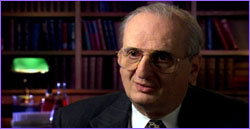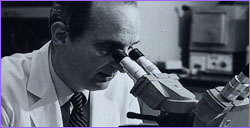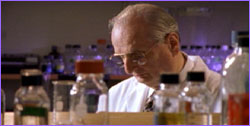
|

|
|
 Dr. Judah Folkman
Dr. Judah Folkman
|
Dr. Folkman Speaks
In 1961, while conducting medical research in a U.S. Navy
lab, Dr. Judah Folkman stumbled upon a hidden secret about
how cancer grows. Before the decade was out, he was
forming the theory that would occupy the rest of his
professional life. He called that theory angiogenesis, and
in it he postulated that tumors could not grow larger than
the head of a pin without a blood supply. He also believed
that the tumor secreted some mystery factor that
stimulated new blood vessels to form, bringing nutrition
to the tumor and allowing it to grow.
But Dr. Folkman went even further: He also proposed that
if the new blood-vessel growth to the tumor could be
blocked, that might offer an entirely new way to treat
cancer. After decades of work, Dr. Folkman and his team
are now watching as clinical trials begin with two
recently discovered angiogenesis inhibitors, endostatin
and angiostatin. In this interview, drawn from those
conducted for "Cancer Warrior" by NOVA producer Nancy
Linde, hear Dr. Folkman talk about his team's
ground-breaking discoveries and his hopes and fears for
the new therapy.
NOVA: What was your first "Eureka" moment with
angiogenesis?
Dr. Folkman: The first one was in the 1960s when we
saw that in the isolated organs growing in the glass
chambers in the Navy that the tumors implanted there all
stopped at the same size. There should have been a
bell-shaped curve like in all biology, but all the same size
meant that something was stopping them. It took a few years
to figure out it was the absence of blood vessels. I had a
feeling this is really something important. I didn't have
any idea that it would be some 30 years to try to understand
the process by which tumors are able to recruit their own
private blood supply and just keep going.
NOVA: Such moments must be worth everything,
especially since they're so few and far between.
Dr. Folkman: Most research is failure. You go years
and years and years, and then every once in a while there is
a tremendous finding, and you realize for the first time in
your life that you know something that hour or that day that
nobody else in history has ever known, and you can
understand something of how nature works.
NOVA: When did you first lay out your theory?
Dr. Folkman: A 1971 paper in the
New England Journal of Medicine presented the idea in
a much larger form. One, that the blood vessels in a tumor
were new, and the tumor had to recruit them. Two, that it
recruited the vessels by sending out some factor, which we
called TAF, tumor angiogenesis factor, because we didn't
know what it was that was diffusible. (Diffusion means like
if you put some ink on a table cloth, it travels, but not a
long distance.) Thirdly, we put forward the idea that these
diffusible proteins would bring in the vessels. And
fourthly, that if you could turn this process off the tumors
should stay as small as they had in the thyroid gland and in
the lining of the abdomen that I had seen in surgery, where
they are all the same size and tiny but without blood
vessels.
NOVA: Did you ever fear you were jumping the gun,
since much of the verifying research had yet to be done?
Dr. Folkman: I remember in some early grants I wrote
that I outlined what I thought would be the whole
future—there would be possible inhibitors and
stimulators [of angiogenesis], and there would be pure
proteins. You never these days lay all that out in a grant;
you focus it. Well, I got cold feet and thought, Oh I'm
giving away too much.
|
 Judah Folkman and his team had to conduct hundreds
of experiments before the scientific community began
to accept their unconventional ideas.
Judah Folkman and his team had to conduct hundreds
of experiments before the scientific community began
to accept their unconventional ideas.
|
Now, Dr. John Ender's lab was right next to mine. He had won
the Nobel Prize for the polio virus and was a very great
scholarly gentleman. I showed him this grant and said I'm
worried that I'm giving away too much. He read it right
there. I remember him taking out his pipe, and he said "It
is theft-proof. You'll be able to work at your own pace I
figure for 10 years before anybody is going to believe
this." He thought maybe these ideas were right but that I'd
never be able to convince anybody without dozens of
experiments. It turned out that hundreds of experiments were
necessary over many years.
NOVA: Especially because you were a surgeon and not a
researcher?
Dr. Folkman: Surgery has the disadvantage that the
training takes so long and is so physically demanding. It's
like training for the Olympics practically. There's often
little time for any kind of research or scholarly work, and
surgeons often do not have any ability to have the very long
period of scientific training that basic scientists have.
And so surgeons often are ridiculed because they are thought
not to be able to do research. Yet many great, interesting,
and important advances have come from surgeons.
NOVA: Which is harder in your experience, being a
doctor or being a researcher?
Dr. Folkman: Clinical medicine has tremendous
feedback, so the people who work in it are willing to work
night and day. Patients just call you up all the time and
say you saved my son's life and all that. Research is the
opposite. It's just years of frustration. You have to live
with experiments that don't work and grants that don't get
funded. You have nothing to show for it. You've got critics
all over, and scientists are sometimes mean to each other;
they criticize the ideas in the name of scientific
skepticism. It's not an easy life. You know that line, "I've
been rich, and I've been poor, and rich is better"? Well,
it's easier to be a physician than to be a researcher. I've
been both, and physician is easier.
 Judah Folkman: "I kept saying the ideas, I think,
are right, and it will just take a long time for
people to see them."
Judah Folkman: "I kept saying the ideas, I think,
are right, and it will just take a long time for
people to see them."
|
|
NOVA: What gave you the confidence to go on?
Dr. Folkman: Well, I always thought of it in an
amused way, because I knew something that no one else knew,
and I had been at the operating table. It wasn't the
surgeons who were criticizing, it was basic scientists, and
I knew that many of them had never seen cancer except in a
dish. I knew that they had not experienced what I had
experienced. The idea of tumors growing in three dimensions
and needing blood vessels in the eye, in the peritoneal
cavity, in the thyroid, and many other places, and the whole
concept of in situ cancers and tumors waiting
dormant—I had seen all that. So I kept saying the
ideas, I think, are right, and it will just take a long time
for people to see them.
NOVA: So when did perception of your work start to
change among researchers?
Dr. Folkman: By about the end of the `70s people
began to say, Okay, they are new vessels, we agree. But it's
a side effect of dying tumor cells. It's like pus in a
wound. When Robert Auerbach came [to our lab] as a
sabbatical professor, that was the conventional thinking.
But he did the experiment that disproved that as a single,
crystal-clear paper. He put live tumor cells in one eye of a
rabbit, and he put dying tumor cells in the other, and no
blood vessels came to those, only to the live ones. He said
they must be live in order to recruit the private blood
supply. That single paper changed a lot of people's
thinking.
I would say the watershed year for complete change of
thinking amongst scientists was about 1989. By then there
were such strong experiments coming from our lab, from
Genentec's lab, and from Europe that tumors not only induced
new vessels but were angiogenesis-dependent, that most
scientists began to accept that. But it took a long time.
NOVA: In 1984, your team published a paper in
Science about the discovery of the first angiogenic
factor the year before. That must have stirred things up.
|
 Watch clip of Judah Folkman on "persistence and
obstinancy."
Watch clip of Judah Folkman on "persistence and
obstinancy."
QuickTime
RealVideo:
56K
|
ISDN+
|
Dr. Folkman: That paper had great transforming power.
Almost overnight many, many, many critics were transformed
into competitors, because people began to see that there was
a molecule in this field. That was the first; there are now
17.
I was beginning to wonder whether there would ever been an
angiogenic factor. We had spent so many years on it. In
general, if you don't find something in four or five years,
people say it's not there. In research, there's a very fine
line between persistence and obstinacy. You do not know
whether if you're persistent a little while longer you'll
make it, or whether you're just being obstinate, [and it]
doesn't exist. And, of course, you can keep on going, stay
with an idea too long—[that's] called pigheadedness. I
was beginning to think we had crossed that line and were
spending money and had nothing to show for it.
When that came that was a great sense of relief, that it
actually did exist. It's like Sputnik. The U.S. had all the
information to put up a satellite, but we didn't until
Russia did. Then suddenly we said, Oh you can do it. Once
people saw that it was possible [to find angiogenic
factors], they began to look and found other ones.
Continue: Finding angiogenesis inhibitors
Dr. Folkman Speaks
|
Cancer Caught on Video
Designing Clinical Trials
|
Accidental Discoveries
| How Cancer Grows
Help/Resources
|
Transcript
|
Site Map
|
Cancer Warrior Home
Editor's Picks
|
Previous Sites
|
Join Us/E-mail
|
TV/Web Schedule
About NOVA |
Teachers |
Site Map
|
Shop |
Jobs |
Search |
To print
PBS Online |
NOVA Online |
WGBH
©
| Updated February 2001
|
|
|